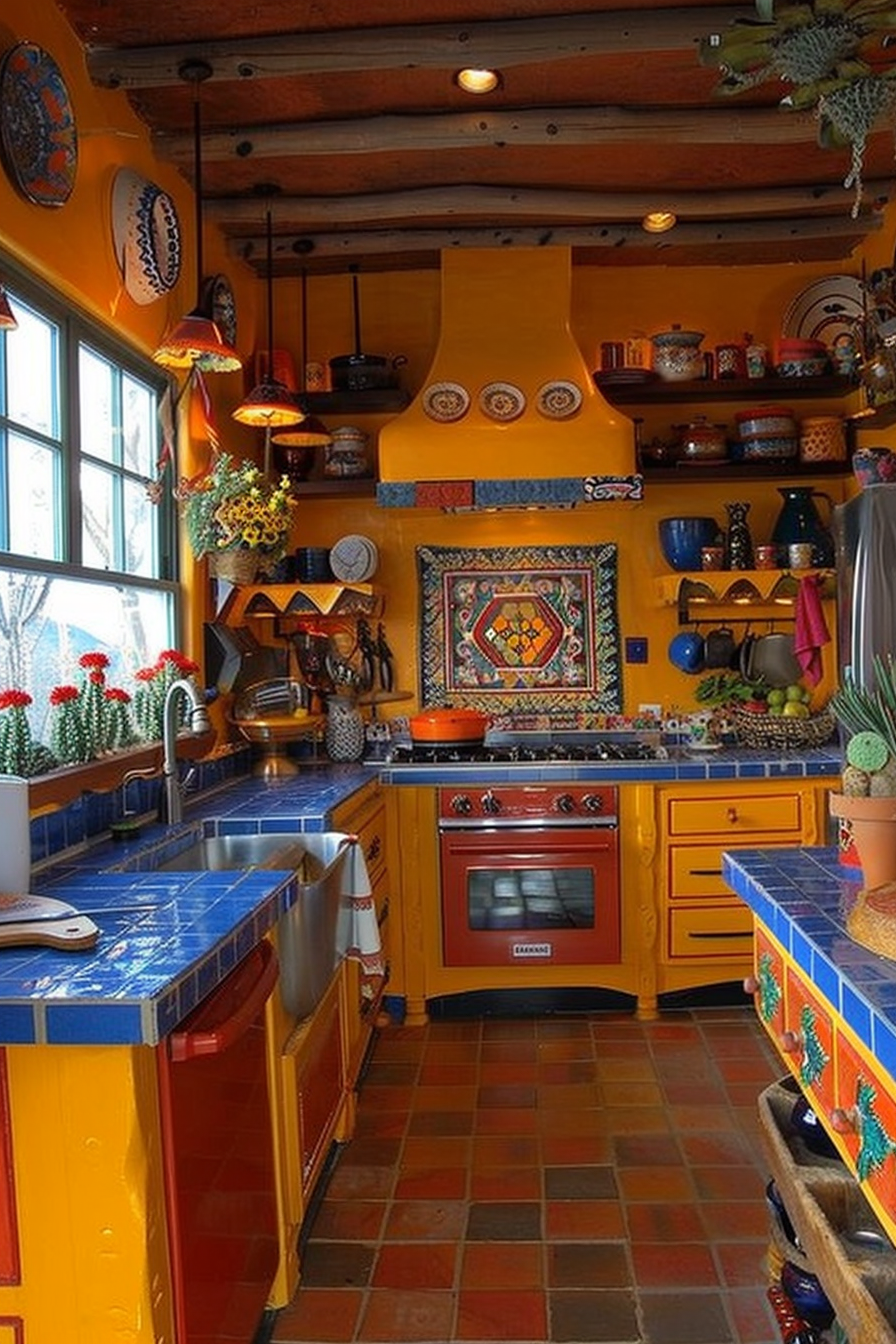I’ve always loved the bright colors and textures of traditional Mexican décor.
When I started planning my own kitchen remodel last year, I knew I wanted to incorporate some of that vibrant style.
This photo right here:
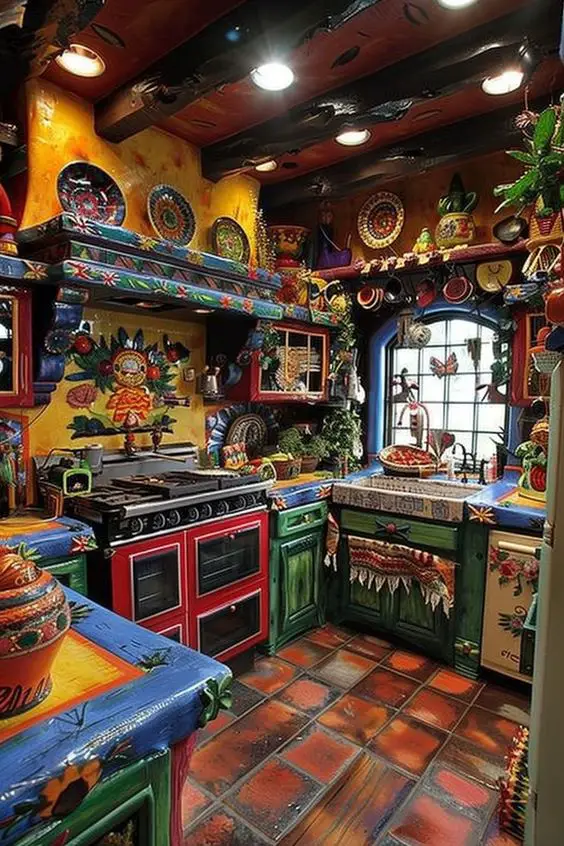
It’s my absolute favorite style when it comes to kitchen design!
Why, you ask?
Because it’s like stepping into a vibrant slice of Mexican culture every time you whip up a meal.
The bold colors, the rustic charm, the handcrafted details – it’s not just a cooking space, it’s a fiesta of the senses.
And you?
You can totally rock this look…
Let’s turn that kitchen of yours into a Mexican design masterpiece!
✨Click to Get My 101 FREE Designer Room Ideas
Warm Paint Colors
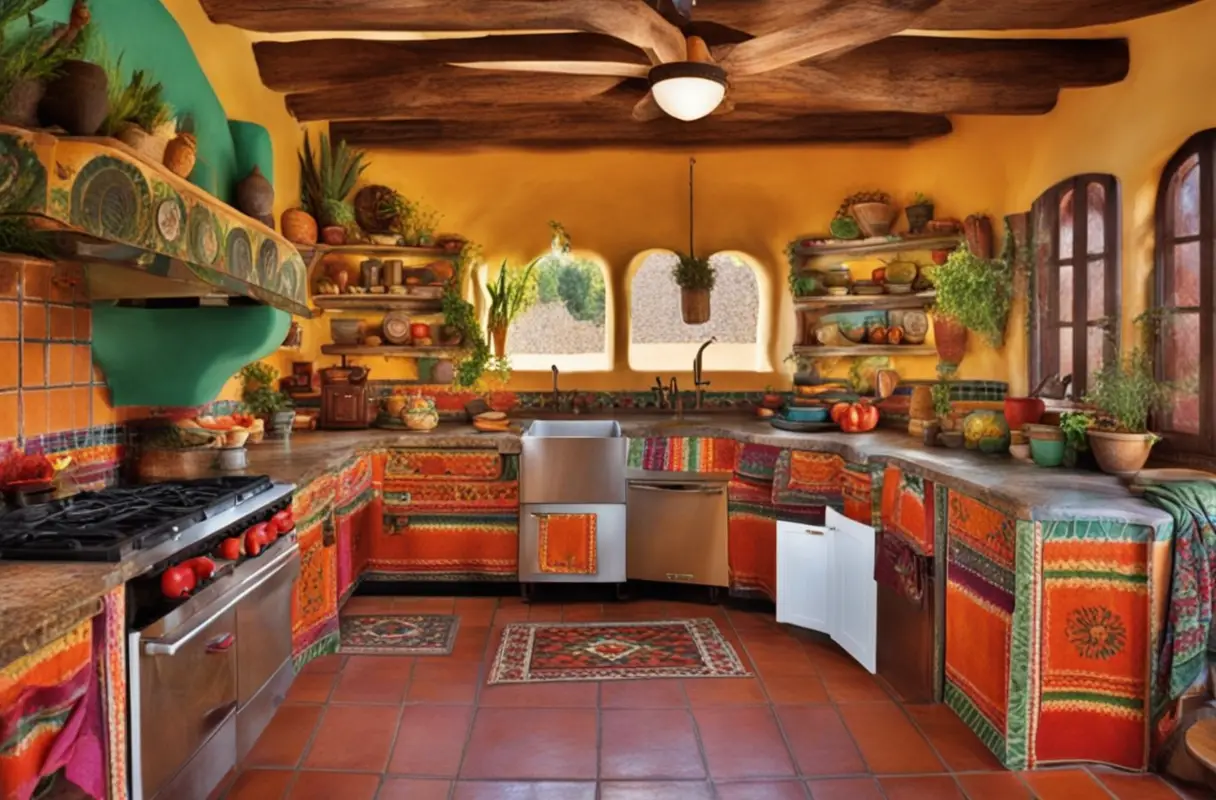
Gotta have that pop of color!
Consider painting your kitchen cabinets or an accent wall in a rich shade like terra cotta, paprika, or sangria.
These warm hues will make your space feel vibrant and lively.
I painted my lower cabinets a deep reddish terra cotta color.
It really makes them pop against the neutral upper cabinets and white subway tile backsplash.
For an accent wall, I’d go for a spicy paprika with orange undertones.
Sangria is more purple-y red that would also look amazing.
You could even do an ombre effect, fading from light to dark across a wall.
Just stick to the warmer red/orange family for that signature Mexican zest.
Beyond paint, look for tiles, fabrics, and accents in these hot, sunny colors.
Handmade terra cotta planters instantly add a taste of old Mexico.
Vibrant Tile Backsplashes
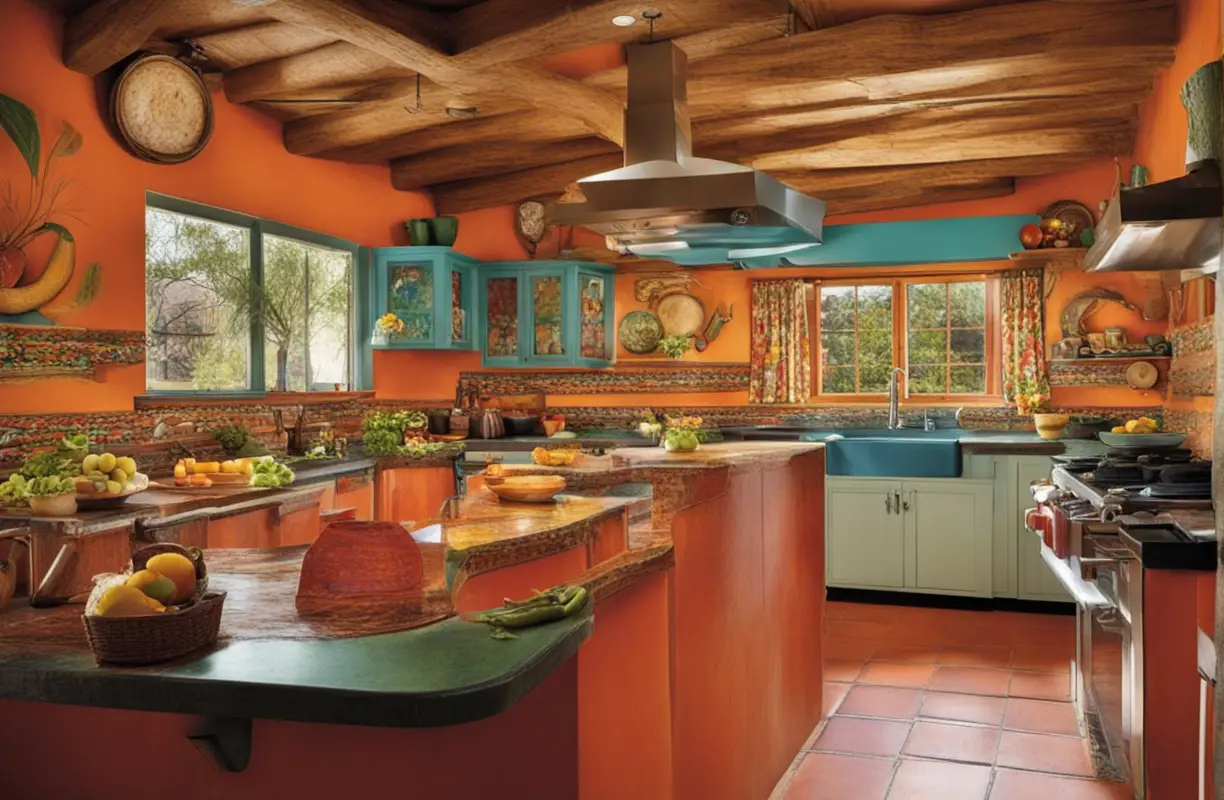
A colorful backsplash is a perfect way to incorporate Mexican design.
Look for handmade ceramic tiles or Talavera tiles in traditional patterns and bright colors.
Arrange them in eye-catching geometric designs or rustic stacked layouts.
I did a Moroccan-inspired diamond pattern in my backsplash using vibrant Mexican tiles.
The colors cascade from emerald to sapphire to orange, almost like a rainbow.
This bold geometric design really pumps up the visual interest.
For a more traditional look, do stacked rows of Talavera tiles in patterns like flowers, animals, or zigzags.
The intricate painted designs will make a gorgeous focal point.
If you can find authentic, hand-painted Talavera tiles, they’ll add artisanal charm.
But you can also get very similar mass-produced tiles for a cheaper price.
Mix glossy and matte tiles for cool contrast, or stick to all gloss for shine.
Woven Textiles
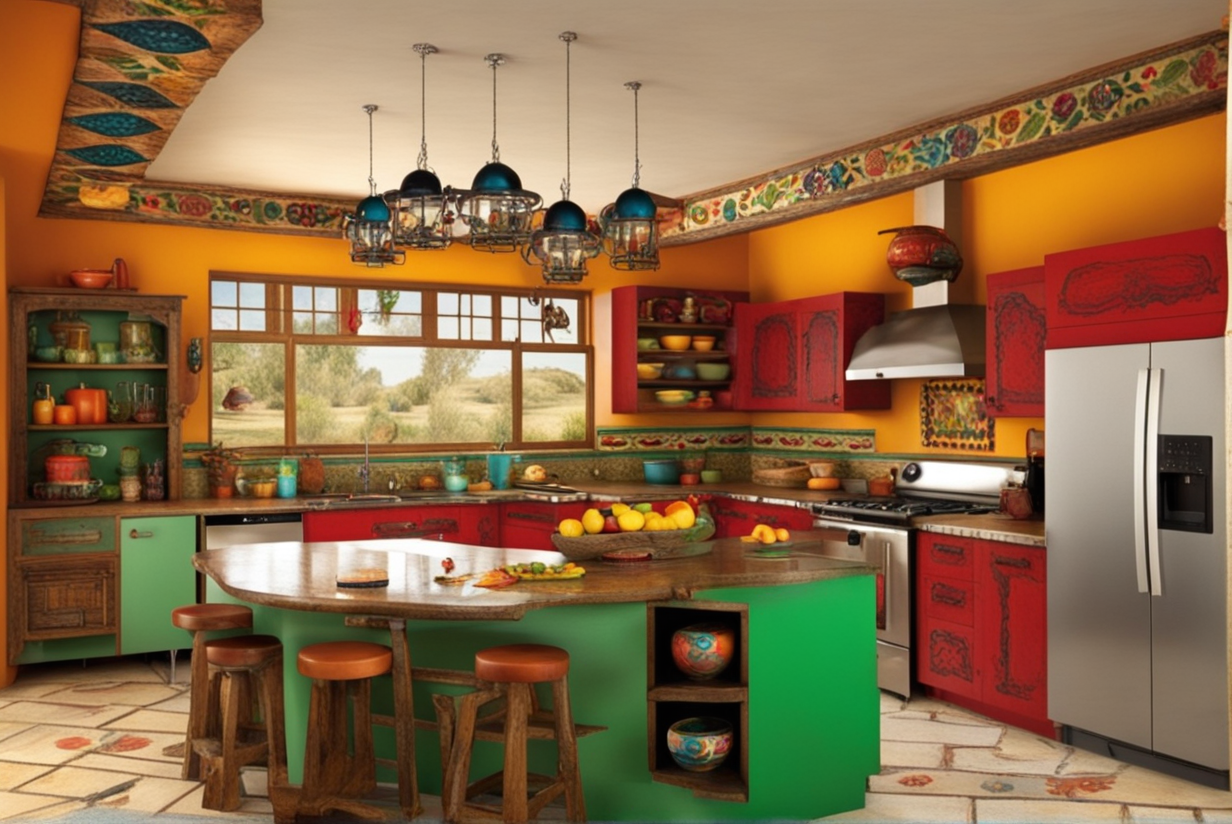
Bring in some authentic Mexican textiles with rugs, curtains, table runners or chair cushions made from colorful woven fabrics.
sarapes and serapes with fringe are stylish options that add movement and texture.
I hung some striped serape blankets on the walls like tapestries to bring in those vibrant colors.
For window treatments, I found a turquoise cotton curtain panel with a Zapotec-inspired geometric pattern.
The white fringe trim gives it such a playful, boho vibe.
I added some coordinating throw pillows made from recycled Oaxacan hippie shirts.
The floral embroidery and hand-dyed look is so unique.
For the table, I purchased a traditional Mexican runner woven from bright cotton threads.
The colorful zigzags and tassel edging make a festive statement.
Don’t be afraid to mix patterns and textures for an eclectic vibe.
Wrought Iron & Rustic Woods
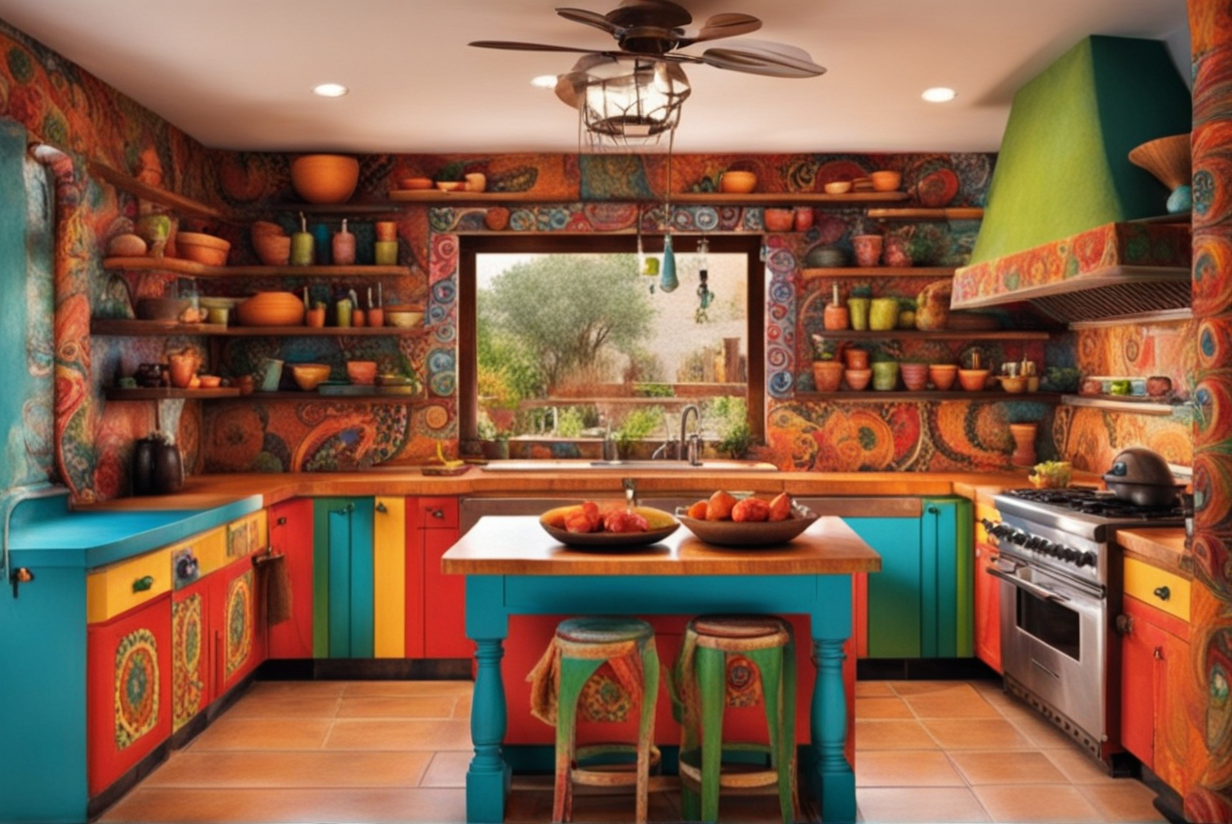
Heavy, hand-forged iron and reclaimed wood have a traditional Mexican look.
Use these materials for shelves, tables, chairs or decorative pieces.
Opt for dark woods like mesquite or rustic finishes.
I found these cool wrought iron candle sconces with intricate cutout patterns that remind me of Spanish colonial style.
Mounting them on either side of the window over the sink looks so striking.
For open shelving, I used solid mesquite boards.
The dark brown wood has gorgeous natural grooves and texture.
I left them unfinished to enhance the rustic vibe.
My dining table has a hand-forged iron base with a solid oak top.
The contrast is beautiful.
And I got vintage ladderback chairs made from old railroad ties that I refinished myself.
✨Click to Get My 101 FREE Designer Room Ideas
Clay Pottery
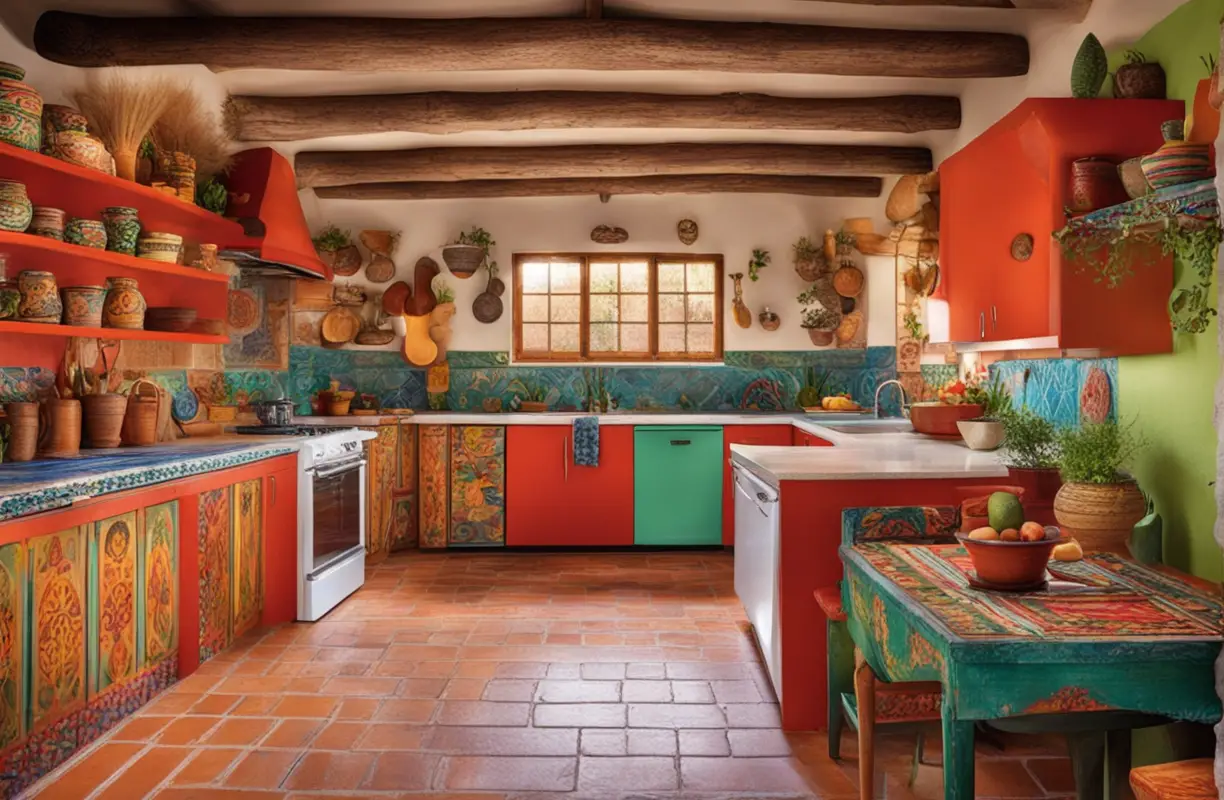
Terracotta pots and hand thrown clay bowls have an organic, earthy feel.
Display them on open shelves or hanging racks for pops of natural color.
Using them as utensil holders is also stylish.
No Mexican kitchen is complete without some terra cotta cookware and serving dishes.
I hung mini cajetes and ollas on the walls to decorate and store my most-used spices and peppers.
For open shelf styling, I have stacks of clay cazuelas and bean pots in different sizes.
Their warm orange tones and handmade imperfections add to the rustic ambiance.
As utensil holders, hammered copper guacamole bowls make a pretty statement.
And giant traditional clay comals are awesome for serving chips and salsas family-style.
Hammered Metal
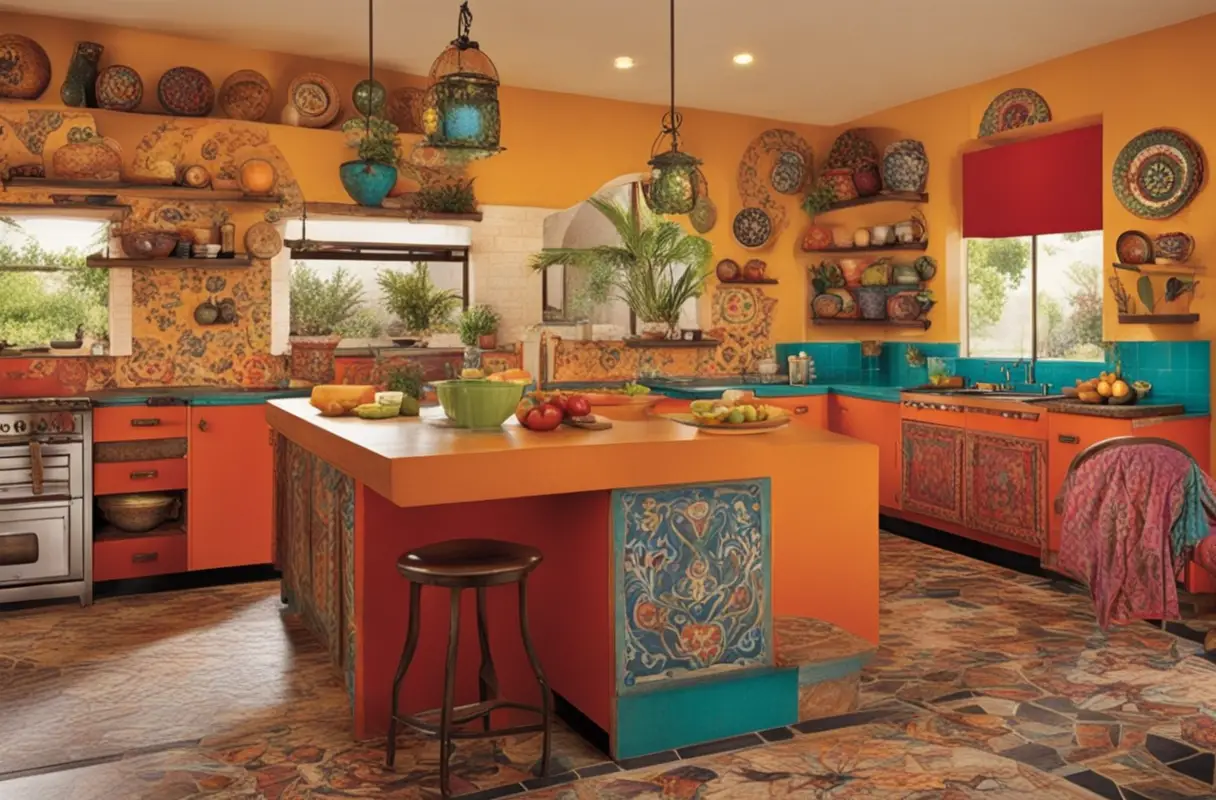
Add some handcrafted flair with lighting, hardware or accessories made from hammered tin, copper or iron.
Sconces, pendant lights and chandeliers with a hand-worked metal look bring artisanal charm.
The first item I bought for my kitchen remodel was a cool wrought iron chandelier with hammered tin shades.
It has an antique, kind of spooky vibe that I adore.
I also found some hand-hammered copper sconces that complement it nicely.
For the sinks, I chose vintage-look faucets made from hammered brass.
And my drawer pulls are cast iron with a hand-forged peened design.
Make sure to polish any unlacquered metal regularly so it doesn’t tarnish too much.
Carved Wood Details
Intricately carved wood is integral to Mexican décor.
Look for cabinet doors, chair backs, shelves or trim with hand-carved patterns.
Geometric designs, flowers and animals are common traditional motifs.
I found the coolest hand-carved mesquite cabinet doors down in Oaxaca.
The deep relief carvings of tropical birds and vines are little works of art.
For a more subtle approach, I added some simple shelving with geometric fretwork supports.
Carved corbels or brackets with acanthus leaf detailing would also look gorgeous.
Chair back and seat carvings add texture in dining areas.
Just make sure carved elements aren’t too sharp or detailed for comfort.
Bold Painted Cabinets
Make a huge impact by painting your cabinets in a vivid shade of turquoise, ochre, burnt orange or lime green.
I took a risk and went for a bold turquoise blue on my upper cabinets.
Against the warm terra cotta lowers, it reminds me of the colors you see on Mexican architecture.
I left the insides of the cabinets a sunny marigold for a cheerful surprise.
On select doors and drawers, I hand-painted some Oaxacan-inspired black geometric designs.
It was tricky getting the lines even, but I love how it came out.
For a more subtle approach, go for deeper ochre or burnt orange cabinets.
Accent with hand-painted clay knobs or colorful woven door inserts.
Vivid lime green would also be fun for a tropical vibe.
Go glossy for maximum impact or use a satin finish for a soft sheen.
✨Click to Get My 101 FREE Designer Room Ideas
Tiled Cabinets
Covering cabinets in colorful ceramic tiles is a trademark of Mexican kitchen style.
Opt for solid blocks of color or busy patterns.
Talavera, saltillo, terra cotta and handmade tiles are great options.
To tile my island, I used affordable Saltillo tiles in a patchwork of sunset colors.
The rough, mottled texture and natural clay tones give it a rustic vibe.
For the perimeter cabinets, I did a Perez tile design in blues and yellows.
The hand painted patterns remind me of vintage Mexican pottery.
Glossy Talavera tiles laid in stripes of color make a bold graphic statement.
Or go for a geometric Arabic-style design in contrasting colors.
Just make sure to seal the tiles properly so moisture doesn’t damage the cabinets.
Open Shelving
Open shelves let you show off all your bright cookware and handcrafted pottery.
Stagger floating shelves at different heights for a dynamic look.
Iron rails and brackets add nice contrast.
I installed open shelving along my entire back wall to display my Mexican ceramics.
The staggered layout creates movement and depth in the small space.
Iron pipe brackets painted marigold pop against the blue cabinetry.
On the shelves, I arranged my collections of Talavera plates, clay mugs, and hammered tin pails.
The organized clutter shows off my fun, casual style.
Open shelves are great for frequently used items you want to access quickly.
Just avoid placing valuables or fragile pieces too close to the edge.
Punched Tin
Also called perforated tin, this material has a lace-like pattern of holes punched in it.
Use it to make a backsplash, hanging light fixture or decorative panels.
The holes cast pretty shadows on the walls.
To add a folk art touch over my stove, I hung a punched tin valance straight across the wall.
It’s embellished with cutouts of chili peppers, cacti, and other Southwest motifs.
The tiny holes sparkle as light passes through, illuminating the designs.
For shelving backsplash, I’ve seen people mount tin sheets printed with scenic landscapes.
Punched tin pendants dangling overhead make fun improvised lighting.
You can find decorative tin panels embossed with Mexican imagery to mount in recessed areas.
Clay Knobs & Handles
Swap out your standard hardware for custom ceramic knobs, pulls and handles.
Hand painted designs or a crackled terracotta look will add unique personality.
I replaced all the boring builder-grade hardware on my cabinets and drawers with handmade alternatives.
The drawer pulls are oval Mexican ceramic knobs painted with blue flowers and yellow dots.
And the cabinet handles are unglazed clay in earthy red-brown hues.
For the stove, I found whimsical Talavera knobs shaped like chili peppers and cacti.
Painted ceramic knobs studded with colorful beads or tiles could also be cool.
Handcrafted leather straps are a rustic choice for drawer pulls as well.
✨Click to Get My 101 FREE Designer Room Ideas
Festive Decorations
Finish off your space with fun decorations inspired by Dia de los Muertos, papel picado, pompoms, and other Mexican folk art.
Vibrant wall art and festive accents will liven things up.
I have a carved wood bushel basket on the wall overflowing with papel picado banners.
The colorful crepe paper cutouts remind me of Mexican celebrations.
I also framed classic loteria game cards to hang in a graphic pattern.
In my window, I suspended clay calaveras skulls left over from Day of the Dead.
Woven pompom garlands draped across cabinets add fun texture and color.
Handpainted signs, vibrant ceramic roosters, and flower-filled vases complete the festive vibe.
Natural Materials
Natural materials like wood, clay, and fibers are integral to Mexican design.
Incorporate organic elements to create a warm, earthy feel.
I built a rustic wood hutch along one wall for open storage and display.
The unfinished pine boards have varying widths for visual interest.
Inside, I lined the shelves with handwoven burlap for a subtle texture.
Terracotta clay pots filled with live succulents add natural life.
I also incorporated a reclaimed wood dining table with an organic irregular shape.
Leaving the natural cracks, knots, and nicks shows off the wood’s raw beauty.
Metallic Accents
Shiny metal accents pop against all the earthy textures in a Mexican kitchen.
Copper and brass add warmth, while iron and tin have an antique appeal.
My range hood is made from hammered copper with a beautiful patina.
The organic dents and divots give it an artisanal, handcrafted look.
The modern copper pots displayed on my shelves provide metallic contrast.
I also incorporated iron sconces, tin light shades, and a forged iron chandelier.
Mixing metal finishes like oil-rubbed bronze, antique brass, or weathered zinc creates depth.
Climbing Plants
Incorporate some living greenery in the form of climbing vines or plants.
They naturally bring the outdoors inside.
I installed copper rods on the walls for vines to climb up.
Jade pothos and philodendrons cascade down, lending organic texture.
Hanging air plants clipped onto mounted chicken wire also work.
For herbs, mount planters with trailing rosemary, mint or oregano.
Vines framed in a latticework panel on one wall would be gorgeous too.
Just be sure to maintain the plants and prune back aggressively as needed.
✨Click to Get My 101 FREE Designer Room Ideas
Colorful Flooring
Why limit the color to just the walls and cabinets?
Paint or stain the floors in vibrant southwest hues as well.
I stained my old pine floors an intense achiote red.
The bold tone energizes the whole space.
Deep aqua blue or turquoise would also be an eye-catching choice.
Terracotta Saltillo tiles in elaborate patterns make a traditional statement.
For fun patterns, arrange colorful tiles in stripes, diamonds or zigzags.
Just make sure the flooring is durable enough for high-traffic cooking areas.

